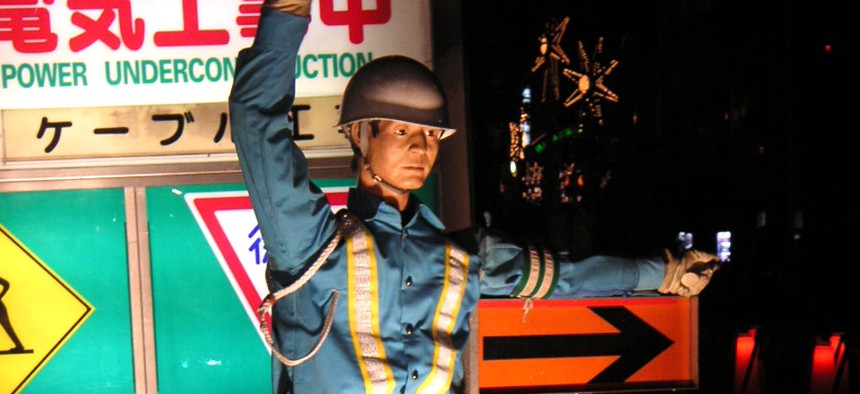Japan's Drivers Must Obey Traffic Robots

Flickr user antjeverena
Entering a construction zone in Tokyo can involve interactions with waving humanoids.
Do American drivers know the extent to which they're being deprived, signage-wise? When motorists enter a construction zone in this country, they'll likely to run into a bunch of orange signs or, at the flashiest, a glowing arrow like this one:
(
@neotsn / Flickr
)
It's fine enough if the goal is to simply get people to move their vehicles safely through the zone. But if construction engineers wanted to add a sense of wonder and fun to the experience – or flesh-tingling creepiness, depending on your viewpoint – what else could they add?
Japan has the answer and, as is often the case, it is: robots. When the country's road crews want to mark out a repair zone, they head to central storage and pull out a variety of anthropomorphic signals with arms that wave drivers into the correct lane. These dead-eyed entities range in sophistication from electronic cartoons to crude scarecrows to quite realistic, but disembodied torsos escaped from the Uncanny Valley to infest our nightmares.
The Japanese call them A nzen Taro , which roughly translates to "Joe Safety," according to traffic-robot fan Patrick Benny. "There are many types around, and complexity goes from a simple-looking metal plate to sophisticated clothed mannequins, but all of them have a robotic arm," says Benny at his Flickr group, " Robots for Safety ." Sometimes they even "come in the form of a large LED screen showing a construction worker waving a flag."
I was ambushed by one of these mechanized guys during a recent trip to Tokyo (it was this dude , gesticulating with a light saber). But browsing through Benny's collection, I was amazed at the eclectic variety of arm-churning 'bots earning overtime to make Japan's roads secure for travel. I'm still scratching my head at why Japan uses these things – perhaps a dumb question for a nation whose capital has a giant robot-infested nightclub . But one Flickr user touches on something feasible sounding when he says , "I think people are more responsive to the human form, and so are more apt to pay attention to a robot or mannequin than a sign perhaps."
Read more at The Atlantic Cities .






